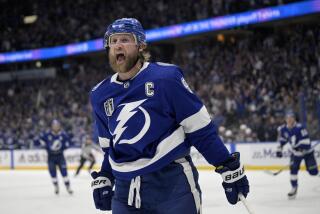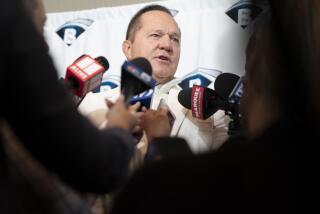FACEOFF CIRCLE
A year from today, a new era of labor peace and stability could be dawning over the NHL.
Or, rinks across North America could be turning out the lights, signaling the start of a labor dispute that could threaten the future of half a dozen clubs.
The collective bargaining agreement between the league and the NHL Players’ Assn. reached after a 103-day lockout that cut the 1994-95 season to 48 games, expires one year from Monday. That leaves 365 days -- 2004 is a leap year -- to transform rhetoric into solutions.
Is there enough time to forge an agreement that will sustain a league that’s already at the bottom of the U.S. major-sports heap and whose national TV deal with ABC/ESPN ends after this season?
“I think a work stoppage in hockey would be catastrophic to the sport,” said Allan Walsh, an agent with the Beverly Hills Sports Council, whose clients include young stars Marian Gaborik of Minnesota and Martin Havlat of Ottawa. “I think it would be akin to both sides putting a bullet in a gun and blowing their brains out. And I don’t think that both sides really want that.”
Walsh says he senses he’s in the minority in thinking hockey will copy the example Major League Baseball set last summer and avert an interruption.
“I believe it’s going to come down to the wire,” he said, “and I’m talking about the last possible minute, but that both sides, at the 11.59th hour, are going to cut what they perceive to be the best deal possible for themselves.”
The gulf between those perceptions, however, seems vast.
Owners say salaries have risen faster than revenue, leading them to spend 68% of revenue on payrolls and lose millions of dollars.
If there’s no agreement and the NHL locks players out?
“In Anaheim, we’d lose considerably less than we’re losing now,” Mighty Duck General Manager Bryan Murray said.
And he’s not alone.
“The system has not worked the way we intended it to work and it has to be changed,” said Bill Daly, the NHL’s chief legal officer. “I don’t want to speculate [about effects of a stoppage]. I would be concerned about the long-term viability of this league in this form if we don’t fix the CBA. That’s why we have no margin of error.”
Under business initiatives instigated by Commissioner Gary Bettman, the NHL’s revenue rose to about $1.9 billion last season, from $600 million a decade ago. But the average player salary, which was $558,000 in 1993-94 under the old agreement, hit $1,790,209 last season, according to the NHL.
Each club annually gets about $5.7 million in national TV revenue. Each NFL club got about $75 million in TV money last season, and its average salary was $1.25 million. The NHL’s situation is complicated by inequities between the U.S. and Canadian dollars, a reason it provides subsidies to Canadian teams that meet certain quotas for season-ticket sales and advertising.
The NHL is alone among the four major North American professional leagues in not having a salary cap or luxury tax. During the 1994-95 talks, the union proposed revenue sharing through a graduated levy on player payrolls of the top 16 revenue teams and a levy on gate receipts, but owners refused. They compromised on a cap on salaries for the first three years of players’ careers, but that was circumvented by bonus clauses.
“This was a decent agreement, there was no question, as far as tools being there for us to do certain things,” Murray said. “But teams found ways to go overboard, and agents found ways and the union found ways to get past the entry-level cap. It has been as big an issue as anything. When you’ve got the possibility of a guy earning $3 or $4 million in bonuses a year, that affects your budget. The salaries -- you think you have under control, then all of a sudden your budget is being blown out.”
One idea being floated widely is a $35-million hard cap, about half of the Rangers’ and Red Wings’ payrolls last season. Bettman won’t specify whether owners seek a cap or luxury tax, and the NHL has fined club executives who have discussed the matter.
“You need to have cost certainty because nothing else seems to work,” he told Canadian sports and business leaders last week, adding, “I promise a new system can and will be attained.”
Say players: Try self-restraint and good management techniques instead of asking the NHL to curb your worst impulses.
“The key issue is maintaining a fair marketplace for salaries,” said Bob Goodenow, executive director of the NHLPA. “Clubs can already have cost certainty under the current agreement. They can set a budget and stick to it. We’ve seen it with the Ottawa Senators, Vancouver Canucks and Minnesota Wild and in other places. Cost certainty can be established and maintained on a team-by-team basis.
“It really boils down to teams being able to run their business the way they want and be competitive. People will make counterpoints that they can’t compete against the Rangers, but it’s not so much how much you spend as how you spend it.”
King President Tim Leiweke, a member of the NHL’s executive committee and advocate of major labor changes, opened his club’s books to The Times to support his claim that the club loses millions of dollars each season. Other clubs followed suit.
“We have to have some kind of economic sense here because it’s not a foundation and it’s not a trust,” said Leiweke, who has said the Kings lost $10-12 million last season and will lose $5-6 million this season. “At the same time it’s in everyone’s best interest -- players, fans, owners -- to be in a position where everybody has a chance of making it work and competing on the ice. That’s the best thing that could happen in any sport, and if you don’t believe that, look at the NFL.”
Goodenow said opening the books proved nothing because no club listed arena revenues “and that is the major linkage for NHL teams.... Looking at the overall business enterprise is very complicated and takes a lot of time and effort.”
If owners are drowning in red ink, it wasn’t clear from this summer’s activity.
The Ducks raised their payroll from about $45 million to $52 million, but Phoenix and San Jose cut theirs, saying the move wasn’t in anticipation of a salary cap.
“The economic model that we believe in includes the payroll area right where we are,” said Coyote General Manager Mike Barnett, whose payroll will be in the low $30-million range. “We feel we can be competitive at that level and I don’t see any reason to change. I’ve always believed in the concept of drafting properly and developing your own players and building from there.”
San Jose’s Doug Wilson will have a payroll in the high 30s, down from the mid-40s last season, partly because the Sharks are no longer paying players they’d traded.
“How I spend my money and build is going to be based on drafting and developing and making good hockey decisions,” Wilson said. “I don’t care what the system is. I’m positioned for whatever system that comes down.”
Long-term signings might have been less common, but many teams plunged in. Derian Hatcher (five years, $30 million with Detroit), Sergei Fedorov (five years, potentially worth $40 million with the Ducks), Vaclav Prospal (five years, $16.5 million from the Ducks) and Jere Lehtinen (four years at an average of $3.6 million with Dallas) got healthy deals. Also, Dallas gave Mike Modano an extension through 2004-05 at $9.5 million, a big chunk of payroll if a salary cap comes into play.
“There hasn’t been any money thrown around like in the past. [Owners] are controlling their business better,” said Patrick Brisson, an agent with IMG who represents Fedorov. Brisson also got a four-year, $10-million deal for center Bryan Smolinski before Smolinski became a free agent, and a four-year, $13-million deal for defenseman Greg de Vries with the Rangers.
“The way I read this, and I’m always a little optimistic, that compared with the current CBA obviously things will change,” Brisson said. “The way teams are managing the current CBA, they’re finally doing it in a way that’s good for them.”
But is it too late? The NHL long ago told each club to pay $10 million into a fund that could be tapped for operation during a stoppage. Agents regularly caution clients to spend carefully in case paychecks stop coming a year from now.
“It’s reality,” Brisson said. “It’s not adversarial, just preparation. It could be a month, it could be a year. We’ve got to be careful to educate them about what could happen. That’s our duty.”
Daly and Goodenow say they talk often but have reached no agreements.
“I certainly believe there’s time to get it done,” Goodenow said. “We’re committed to trying to do something in these negotiations. We’re committed to not having a disruption, and if it comes, it will come from the other side in the form of a lockout.”
Said Daly: “I really think the issue is simple. You get in a room and talk about what the business generates and what a fair and equitable division of revenues is. You get that, and all the big issues -- what free agency looks like and everything else -- can fall into place very quickly.”
*
(BEGIN TEXT OF INFOBOX)
Players’ Share
*--* Year-by-year NHL salaries: 1990-91 $276,000 1991-92 $368,000 1992-93 $465,000 1993-94 $558,000 1994-95 $733,000 1995-96 $892,000 1996-97 $981,000 1997-98 $1,167,713 1998-99 $1,288,974 1999-2000 $1,356,380 2000-01 $1,434,885 2001-02 $1,642,590 2002-03 $1,790,209
*--*
Source: NHL
More to Read
Go beyond the scoreboard
Get the latest on L.A.'s teams in the daily Sports Report newsletter.
You may occasionally receive promotional content from the Los Angeles Times.







